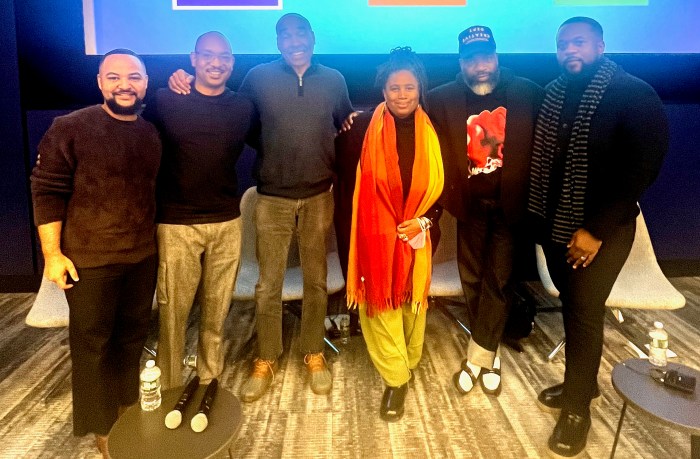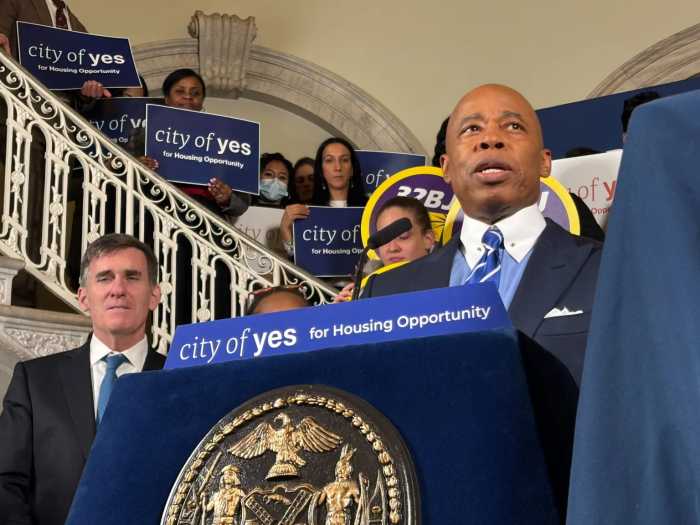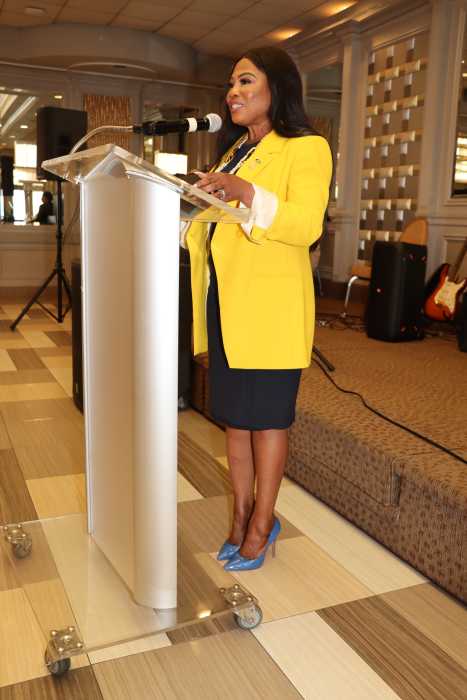Utopian wonderland charged with political energy
Claire Oliver Gallery is currently featuring a site-specific installation by the Russian artist Georgii “Gosha” Ostretsov — who has been part of the Moscow art scene since the mid-1980s. Eclectic, and as visually overwhelming as it is enticing, “Coolville” is comprised of painted, mural-sized canvas comic strips that sparkle through vivid color and form. Arranged along the walls, suspended from the ceiling, and contrasted with the occasional life-size figurative sculpture, the paintings have not only taken over the gallery’s exhibition space; they’ve transformed it into a science fiction wonderland.
When asked how the concept for “Coolville” developed, Ostretsov explains that it began with his search “for the meaning of the word ‘beautiful’ on the Internet.” Using the Russian to English dictionary, “the word ‘Coolville’ came up and the beautiful Utopian village in the gallery” got its name. Despite a sense of playfulness, the mood here is serious and the tone satirical (an “enduring characteristic of Russian culture” according to the press release). Ostretsov’s world is one charged with political energy and rebellious spirit. In this project, the biggest challenge (besides creating an entire utopian city in the middle of a gallery space) was “to explain the story of the Russian artist to a new American audience.”
Although he has exhibited extensively in Russian and Europe, “Coolville” marks Ostretsov’s U.S. debut — a fact which has a keen impact on this particular project. While as a conceptual artist Ostretsov expresses his ideas in various forms, “Coolville” aims to combine Eastern and Western ideas. Ostretsov draws inspiration from the early 19th century literary works of Gogol, the absurdist’s writings and the theatre of OBERIU (a short-lived avant-garde grouping of Russian post-Futurist poets in the 1920s and 1930s) — as well as from the seminal narrative installation works by the Russian-American conceptual artist Ilya Kabakov.
Most importantly, “Coolville” employs a style derived from Pop Art and Western comics — which Ostretsov views as a “universal language between Eastern and Western cultures.” Indeed, they are easy to follow and comprehend, as their narratives unfold in a largely visual manner.
However, to Ostretsov (who was born in Moscow in 1967), there is another important aspect. “In the Soviet Union, comics were prohibited as capitalist propaganda,” he explains. The Bolsheviks had banned comics due to their “bourgeois” Western origins. Despite occasional appearances in children’s magazines like “Murzilka” or “Veselie Kartinki,” they continued to exist largely in the underground — until the Perestroika era in the late 1980s. It was because of their controversial if not secretive status that Ostretsov, became “attracted to comics as an antagonistic way to express [himself].” They were not a part of the everyday, but instead contained a taste of revolt. Cartoons are not “pop but protest!” as Ostretsov puts it.
“Coolville” is a bizarre realm, where the artist takes on the role of a superhero. In his hands, art becomes a powerful tool against all kinds of evil, enabling him to wrest control from a reviled regime and create a new world. It is a story of struggle, victory and progress. But the struggle to push ahead is not without its emotional challenges, and Ostretsov occasionally masks his superheros as to provide them with an extra layer of protection (or, as he admits, to establish a barrier fear; the artist manifests as a protector or teacher to society at large).
When asked what kind of teachings his superheroes might like to convey, he explains that he would like to “show a way how people could live tomorrow.” Pondering that every day there emerges new examples of how this futuristic life might materialize, he wonders if the destruction of patriarchal superiority and its replacement with a matriarchal system could be the answer. Ostretsov argues that the most important requisite of a leader should be a general love for the people. As women give birth to boys and girls, and so have been equipped by nature to love members of both sexes equally, they might be the solution.
“Coolville” is part of Ostretsov’s ongoing New Government project, on which he has been working since the late 1990s as a commentary on the nature of power and despotism in post-Soviet Russia. Based in a Euro-Christian culture, Gosha’s heroes “rally against ternary and The New Government [and] through comics this story can be easily told.” In the past he stated: “As the acting organ of power, the New Government must demonstrate its operative status; closely watch over the mass media, so that the reality of historical events does not undergo distortion; react quickly to disasters; carry out a policy of scientific-technological progress; provide for the evacuation of the globe’s population in the event of planetary catastrophe; vigilantly ensure general adherence to the Constitution; act as a punitive power; give some attention to the development and support of cultural-educational activities; and engage as much as possible the intellectual potential of man.”
This summer, more can be seen of Ostretsov’s work as the artist will represent The Russian Federation in the 53rd Venice Biennale. For the biennial, which runs from June to November, Ostretsov has put together an autobiographical installation in which he “constructed the house where [he] lives and in the last of six rooms sits a self-portrait robotic sculpture who draws an eternal ‘0’ on the table. This symbolizes both infinity and nothingness. By making art I cheat death — It will live on past me.”
GOSHA OSTRETSOV: “COOLVILLE”
Through June 27
Claire Oliver Gallery
513 West 26th Street
212-929-5949 or www.ClaireOliver.com


























